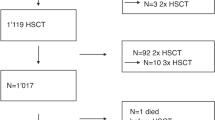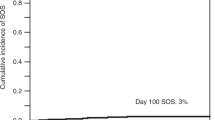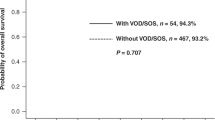Abstract
Hyperbilirubinemia in the early phase after allogeneic hematopoietic SCT (HSCT) is due to various causes. One of the most important causes of hyperbilirubinemia is veno-occlusive disease/sinusoidal obstructive syndrome (VOD/SOS). However, the prognosis of patients who are clinically diagnosed as SOS varies. We retrospectively evaluated 82 patients who underwent their first allogeneic HSCT. GVHD prophylaxis was a combination of short-term MTX and CsA (n=77) or tacrolimus (n=5). Thirty-three patients developed hyperbilirubinemia, with a bilirubin level of at least 2 mg/dL, within 20 days after HSCT. Of these patients, 24 were diagnosed as VOD/SOS using the modified Seattle criteria. Twenty-six recovered to a bilirubin level of <2 mg/dL. We focused on the serum alkaline phosphatase/total bilirubin ratio (ALP/TB) at the onset of hyperbilirubinemia and found that it significantly predicted the recovery from hyperbilirubinemia. OS was significantly higher in patients with a lower ALP/TB ratio (P=0.00056). In addition, a lower ALP/TB ratio was associated with better survival even in patients who were clinically diagnosed as SOS (P<0.001). The ALP/TB ratio at the onset of hyperbilirubinemia may be a useful predictor for the prognosis of hyperbilirubinemia and SOS early after HSCT.
This is a preview of subscription content, access via your institution
Access options
Subscribe to this journal
Receive 12 print issues and online access
$259.00 per year
only $21.58 per issue
Buy this article
- Purchase on Springer Link
- Instant access to full article PDF
Prices may be subject to local taxes which are calculated during checkout





Similar content being viewed by others
References
McDonald GB . Hepatobiliary complications of hematopoietic cell transplantation, 40 years on. Hepatology 2010; 51: 1450–1460.
Bearman SI . The syndrome of hepatic veno-occlusive disease after marrow transplantation. Blood 1995; 85: 3005–3020.
McDonald GB, Sharma P, Matthews DE, Shulman HM, Thomas ED . Venocclusive disease of the liver after bone marrow transplantation: diagnosis, incidence, and predisposing factors. Hepatology 1984; 4: 116–122.
Jones RJ, Lee KS, Beschorner WE, Vogel VG, Grochow LB, Braine HG et al. Venoocclusive disease of the liver following bone marrow transplantation. Transplantation 1987; 44: 778–783.
Carreras E, Bertz H, Arcese W, Vernant JP, Tomas JF, Hagglund H et al. Incidence and outcome of hepatic veno-occlusive disease after blood or marrow transplantation: a prospective cohort study of the European Group for Blood and Marrow Transplantation. European Group for Blood and Marrow Transplantation Chronic Leukemia Working Party. Blood 1998; 92: 3599–3604.
McDonald GB, Hinds MS, Fisher LD, Schoch HG, Wolford JL, Banaji M et al. Veno-occlusive disease of the liver and multiorgan failure after bone marrow transplantation: a cohort study of 355 patients. Ann Intern Med 1993; 118: 255–267.
Hagglund H, Remberger M, Klaesson S, Lonnqvist B, Ljungman P, Ringden O . Norethisterone treatment, a major risk-factor for veno-occlusive disease in the liver after allogeneic bone marrow transplantation. Blood 1998; 92: 4568–4572.
Coppell JA, Richardson PG, Soiffer R, Martin PL, Kernan NA, Chen A et al. Hepatic veno-occlusive disease following stem cell transplantation: incidence, clinical course, and outcome. Biol Blood Marrow Transplant 2010; 16: 157–168.
Atkinson K, Biggs J, Dodds A, Concannon A . Cyclosporine-associated hepatotoxicity after allogeneic marrow transplantation in man: differentiation from other causes of posttransplant liver disease. Transplant Proc 1983; 15: 2761–2767.
Ogawa N, Kanda Y, Matsubara M, Asano Y, Nakagawa M, Sakata-Yanagimoto M et al. Increased incidence of acute graft-versus-host disease with the continuous infusion of cyclosporine A compared to twice-daily infusion. Bone Marrow Transplant 2004; 33: 549–552.
Oshima K, Sato M, Terasako K, Kimura S, Okuda S, Kako S et al. Target blood concentrations of CYA and tacrolimus in randomized controlled trials for the prevention of acute GVHD after hematopoietic SCT. Bone Marrow Transplant 2010; 45: 781–782.
Gray RJ . A class of k-sample tests for comparing the cumulative incidence of a competing risk. Ann Stat 1988; 16: 1141–1154.
Kanda Y Free statistical software: EZR (Easy R) on R commander. (Accessed 1 March 2012, at http://www.jichi.ac.jp/saitama-sct/SaitamaHP.files/statmedEN.html.)
Lassau N, Auperin A, Leclere J, Bennaceur A, Valteau-Couanet D, Hartmann O . Prognostic value of Doppler-ultrasonography in hepatic veno-occlusive disease. Transplantation 2002; 74: 60–66.
van den Bosch MA, van Hoe L . MR imaging findings in two patients with hepatic veno-occlusive disease following bone marrow transplantation. Eur Radiol 2000; 10: 1290–1293.
Author information
Authors and Affiliations
Corresponding author
Ethics declarations
Competing interests
The authors declare no conflict of interest.
Rights and permissions
About this article
Cite this article
Ashizawa, M., Oshima, K., Wada, H. et al. Hyperbilirubinemia in the early phase after allogeneic HSCT: prognostic significance of the alkaline phosphatase/total bilirubin ratio. Bone Marrow Transplant 48, 94–98 (2013). https://doi.org/10.1038/bmt.2012.130
Received:
Accepted:
Published:
Issue Date:
DOI: https://doi.org/10.1038/bmt.2012.130
Keywords
This article is cited by
-
Early bilirubinemia after allogeneic stem cell transplantation—an endothelial complication
Bone Marrow Transplantation (2021)



